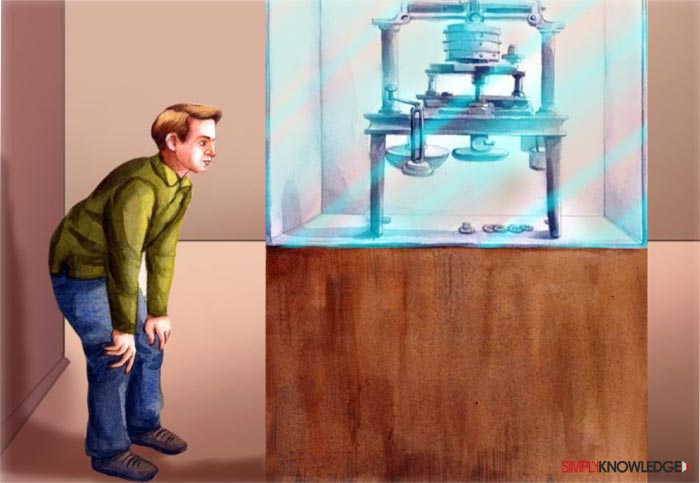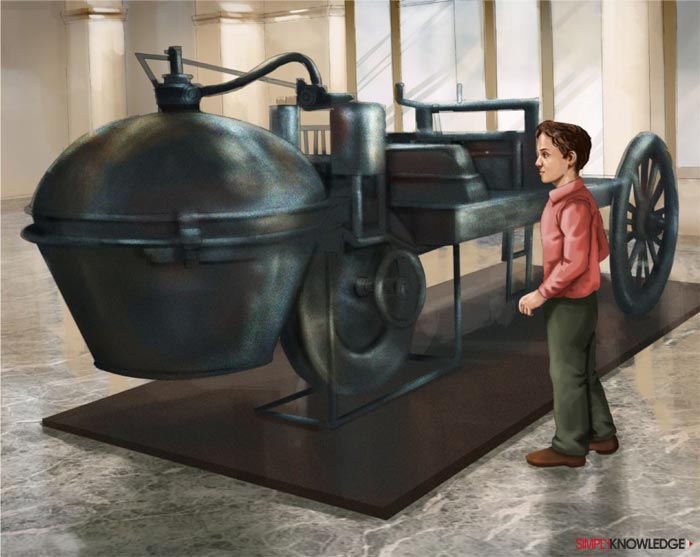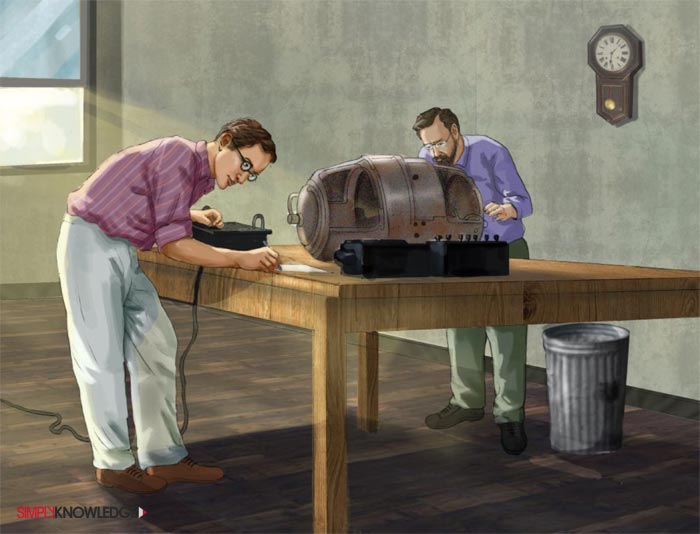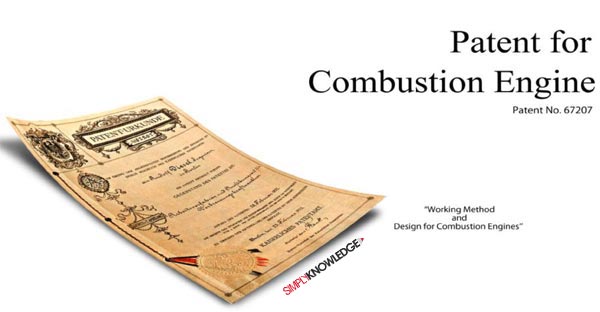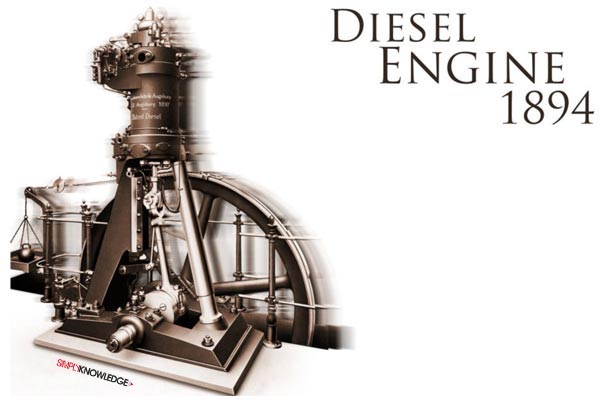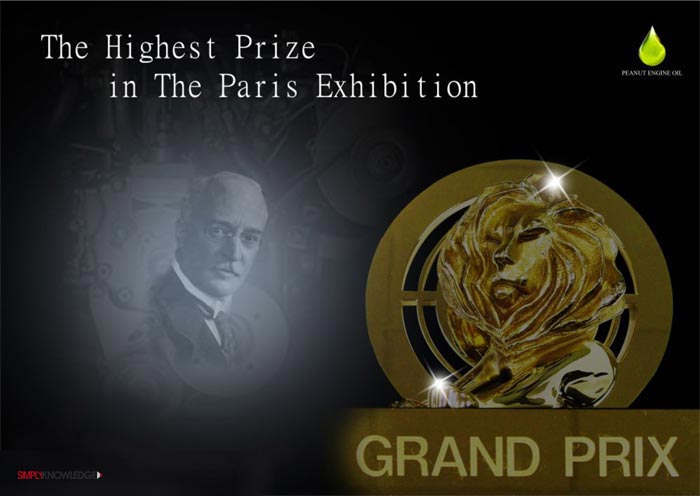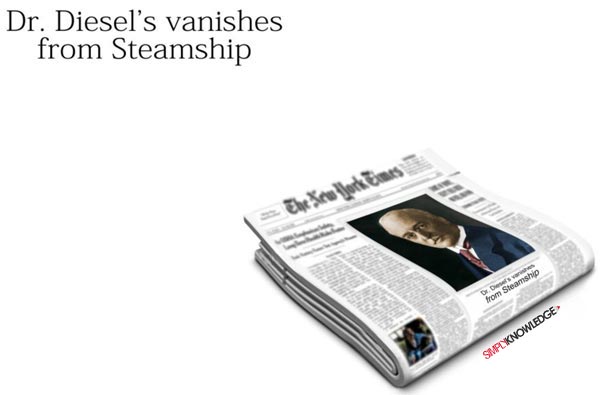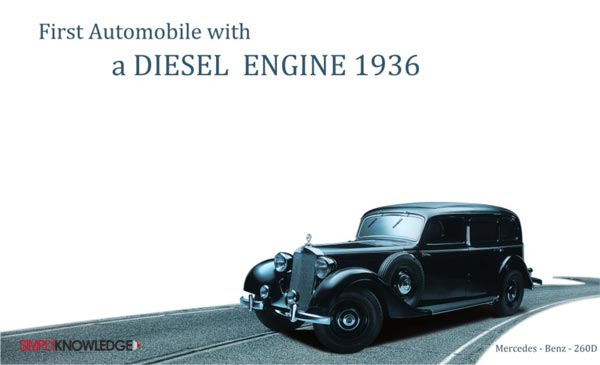


Introduction
The year 2013 brought in happy news for me as I received the much awaited promotion in my organization. So here I was jumping with joy as the prestigious promotion obviously meant hike in remuneration, perks and privileges. The thought of buying a car was first in my priority list for a long time and the right time had finally arrived.
Next day, excitedly I set off to a car showroom to buy a car that would provide the comforts of travelling. The salesman asked me, “Madam, which car would you prefer the one with a diesel engine or a petrol engine??” For a layman like me, an engine is a piece of metal, just black or brown in colour which makes the vehicle go zoom. I stood dumbstruck for a while as the question of the choice of engine opened the pores of my dormant mind. I decided to evaluate the pros and cons of both the engines to arrive at a concrete decision.
After much research and analysis, I decided to opt for an engine which fulfilled at least three core requirements: an engine which gives more mileage, which is not affected by weather conditions, whether dry, rainy or wet, and last but not the least, which is the most economical and cost effective. The answer to all the above queries clearly approved of a car fitted with ‘diesel engine’.
But what is this diesel engine? Who invented it? What purposes does it suffice? Why is it more economical than the petrol? These are some of the common questions that hit your head? To get replies to these questions let’s get into the life of “Mr. Diesel”- Rudolf Diesel, the man behind the discovery of a very powerful and effective combustion engine as compared to steam engine invented by James Watt.
He first invented it, then developed it and finally improved it all in a linear sequence. Let us explore each sequence of his unique discovery that gave the world a truly dynamic engine bearing his name, ‘DIESEL ENGINE’.

Birth Of A Genius
Theodor Diesel, a young man in his twenties had migrated from Augsburg, Germany to Paris in France in the year 1848. He was a leather worker and manufactured small consumer goods. It was in Paris that he met Elise, daughter of a prosperous merchant from Augsburg. The two fell in love and eventually tied the nuptial knot in the year 1855. They began their marital life in a small apartment at 38, rue de Notre Dame and were soon blessed with a pretty daughter, Louise in 1856. The small family was going through happy times and within a span of two years, Elise and Theodor became proud parents of a bonny baby boy, Rudolf Diesel, on 18th March, 1858. Theodor’s business was booming and the family moved into a double-story apartment in rue de la Fontaine au Roi where Elise and Theodor had an addition to their family, a daughter named Emma in the year 1859. Theodor successfully established his small business of manufacturing leather in the downstairs of his apartment and worked from dawn to dusk and six days a week.

Curiousity! The Best Teacher
As a young child, Rudolf was very observant and had a questioning mind. He would spend a lot of time in the grand Musee des Arts et Metiers, where he would get lost in every detail of pacesetting new technologies like steam power, electricity, photographic film, telecommunications and the phonograph. Nicholas-Joesph Cugnot’s steam engine always caught his attention and left a lasting impression on the young boy.
His curious nature almost got him killed when he fiddled with his apartment’s gas distribution system. Theodor was a strict man, and any lies and mischiefs by little Rudolf Diesel was met with severe punishments. He was not allowed to bring his friends at home as his father did not approve of him mixing with other children. The discipline enforced by his father proved to be too authoritarian and drove Rudolf into a shell. He became an introvert and suffered severe bouts of headaches.
Rudolf was enrolled in a local school in Paris; his academic performance was excellent as he was very fluent in three languages. German was his mother tongue, French was taught at School and English was taught by his mother who had once worked as a governess to an English family in London. By the time Rudolf finished his elementary schooling he was twelve years old and was awarded a bronze medal by the ‘Societe Pour L Instruction Elementaire’ for outstanding academic performance in the year 1870.
Around the same year a war broke between France and Prussia and the Diesel family was forced to leave France due to their German origin. On 6th September, 1870, the family boarded a steamer from Rouen to New Haven in England. The family was struck hard financially; they managed to find a job for Lousie at a private school. Rudolf was enrolled at a local school in London and continued to receive education. His curious and observant nature drove him to visit the British Museum and South Kensington Museum which exhibited scientific and engineering components which highly impressed him.
However Rudolf’s stay in London was short lived as his father’s cousin Betty Barnickel offered to take Rudolf to her house at Augsburg, Germany.

Inclination Towards Engineering
Betty Barnickel was married to Cristoph Barnickel, a professor of Mathematics at Augsburg’s Royal District Trade School. The couple found Rudolf very charming and handsome and accepted him with open arms. They enrolled him for a three year program at Koniglichen Kreis Gewerbsschule which was the best in terms of amenities like chemistry lab, art gallery and machine. Rudolf made best use of these amenities provided and by the time he was 14, he had decided that he wanted to be an engineer. He conveyed his desire to become an engineer through a letter, to his parents who were in Paris.
Around July 1871, the war between France and Prussia had come to an end and Theodor was anxious to get back his son from Barnickels. He wanted Rudolf to earn a decent living and provide financial stability as Lousie was struggling hard to keep the family going.
Rudolf finished his industrial schooling with flying colours with specialization in mechanics and returned to Paris to help his father financially. But fate had something else stored in for Rudolf. Immediately after his return, tragedy struck the Diesel family, as Lousie expired due to a massive heart failure. The Barnickels again requested Theodore to send Rudolf back with them to Augsburg, to which Theodore agreed.
The Barnickels enrolled Rudolf in the mechanical engineering program. His academic performance was excellent and he was the youngest student with the highest mark ever. Seeing his brilliant performance, the Munchen Polytechnic awarded him scholarship to pursue his studies in mechanical engineering. During his course of academics in the Institute, he met Professor Carl Von Linde, who was famous for developing refrigeration and gas separation technologies. Rudolf assisted Carl in his lab and by 1878 he was dismayed by how inefficient the steam engine was compared with the original Carnot heat engine. He conducted various experiments on the subject and tried using coal directly in the engine as fuel. During the course of his work he made few friends and life was sailing smooth. Theodore and Elsie too joined him at Munchen and were pleased to see that their son had grown into a tall and handsome man, towering at a height of 185 cm.
Rudolf too was pleased to have his parents with him but he found his father a little strange. Death of Louise had made a huge impact on his father and had turned him into a spiritual person. He would spend most of his time in prayers and had established himself as a faith healer.

Origin Of Diesel Engine
Before we read further on the circumstances that led to the discovery of diesel engine, we have to look back into history to find its origin. As stated earlier, the origin of Diesel engine is closely related to the history of steam engine. The Greeks and the Romans were aware of the fact that steam could somehow be harnessed to perform useful jobs. However, the concept of obtaining power from steam was soon forgotten for ages and later when there was a requirement for lifting water for coal mines, steam was introduced into larger vessel and low pressure was created for sucking water to be pumped. In 1710, an English scientist, Thomas Newcomen, introduced a cylinder piston with which “water could be pumped from greater depths as the condensing steam in the cylinder pulled the piston down to create the pumping action.”
Half a century later, in 1765, “James Watt wanted to avoid the cooling of hot chamber containing steam by introducing a separate condensing chamber.” The necessary theoretical framework for the design of the steam engine was published by Sadi Carnot, a French engineer, in 1824, in his book titled, “Reflections on the Motive Power of Fire”. In his book, he elaborated on the heat engine, which he called as Thermodynamic Process, receiving heat from a hot source and delivering work output simultaneously rejecting the remaining heat to a cold source. However, Sadi Carnot’s theory went unnoticed till 1834, when William Thomson, later known as Lord Kelvin, a British engineer who first used the concept of thermodynamics for the subject which described the methodology on how steam engines worked, 100 years after James Watt’s steam engine began working.

Stepping Stone To His Career
Rudolf was keen to pass his final exams and immersed himself completely in its preparation. However, this lead to his health being deteriorated and by the time the exam dates were announced he was diagnosed with typhoid that made him feel miserable. Though he survived the deadly disease, his aunt, Betty Barnickel succumbed to it and so did many other German fellows. He could not give his exams and hence decided to work for a financial security company till the dates for the next exams were announced.
In the year January 1880, Rudolf began to work as an apprentice in the Sulzer Engine Works in Winterthur, Switzerland. The Company was involved in building refrigeration and steam engine; Rudolf Diesel was always impressed by both. He had already worked on the subject with Carl Linde (a German engineer) during his college days and wanted to develop a better way to use energy from the fuel that most efficient steam plants used. He began to read books on the subject and was impressed by Sadi Carnot’s book on Thermodynamics. The book gave us the first law of Thermodynamics which is “heat and mechanical energy are convertible to each other, but are never created or destroyed, only changed in form.” While he was waiting for his exams dates, he had already gained practical experience in the company.
In the same year, he passed his graduation, scoring higher than any other pupil in the university. Armed with honours in academics, he returned to Paris and joined his former Professor Carl von Linde with a design for a modern refrigeration and ice-plant. Professor Carl had resigned from the College and had established his own company called the ‘Gesellschaft fur Lindes Eismaschinen Aktiengesellschaft’ (Linde’s Ice Machine Company). Carl was very impressed with Rudolf’s design and immediately gave permission for the construction of the plant. He then appointed Rudolf as the director of the new plant in the year 1881; Rudolf did not disappoint him and filed for a patent for the production of ‘table ice in glass containers’.

Rudolf’s Family Affair
As Rudolf climbed the ladders of success, his personal life bloomed too. He fell in love with Martha Flasche from United States, who was employed as a governess with a financially strong German family, the Brandes. The Brandes too approved of Rudolf as they found his handsome personality and fat salary hard to ignore. The duo soon took wedding vows in the year 1883 and began their happy marital life. Rudolf continued to work for Carl Linde and gained numerous patents in Germany and France. As a result his financial position too became very strong. As income flew steadily, the couple welcomed their first bundle of joy, a baby boy named Rudolf Jr. in 1883. In a span of two years, they welcomed another addition to their family, a baby girl named Heddy.
After the year 1885, political scenario in France changed and gave rise to negative sentiments against Germans and Swiss nationals. As a consequence, Rudolf’s market for ice machines was hit hard and his income began dwindling. Amongst the growing socio-economic hindrance, the Diesels were blessed with their third child, a boy named Eugen on 3rd May, 1889. As tensions to support a large family grew, Rudolf began to suffer from violent headaches which had suddenly sprung up after his childhood days.

Development Of Theories And Design
Amidst the growing anti-German sentiments in France, Rudolf moved to Berlin with his whole family in the year 1890. He was appointed as the head of Carl Linde’s Corporate Research and Development department. As he was not allowed to use his patents which he developed for his own use, he began to conduct research beyond the field of refrigeration. He began to work on various other theories and then designs of rational heat engine. On 28th February, 1892, he filed for a patent for combustion engine at the Imperial Patent Office in Germany. Within a span of one year he was granted Patent No. 67207 for a “Working Method and Design for Combustion Engines”… a new thermal engine.
He needed a builder to develop it and Rudolf decided to approach Heinrich von Buz, a friend and Director of MAN AG, a renowned Company in Augsburg.
Buz, a proficient engineer who followed his own theories and concepts was not convinced with Rudolf’s design of engine which was based on “The Theory and Construction of a rational heat engine to replace steam engine and contemporary combustion engine”. Rudolf did not give up easily and rewrote the theory. This time Buz accepted the theory and built a model of the engine which was further patented in Germany, USA and England with more defined description of the model.
Based on Rudolf’s work and ideas, a company called ‘Machinenfabrik Augsburg’ supported him to develop his design into a full-fledged machine and provided monetary assistance from other organizations like Krupp and Sulzer Brothers. The monetary assistance provided by the company was utilized by Rudolf for extensive testing and redesigning.
In due course of time Rudolf realized that the path he had chosen would be strenuous, hence, he shifted his family in a modest apartment. He had assumed that his work on the engine design would take only few months but his predictions proved wrong. He toiled hard day and night for the development of his design. He began his work with steam and conducted extensive research on thermal and fuel efficiency. In due course of time, he invented an engine using ammonia vapour. But during the test, the engine exploded causing severe injuries to his eyes and Rudolf had to be hospitalized. After a brief stay in the hospital, he was back to work again at the research center at Augsburg.
Meanwhile, lot of changes happened in his personal life. His uncle Christoph Barnickel who had lost his wife Betty three years back, began dating Emma, Rudolf’s youngest sister. Rudolf initially did not approve of the relationship as the age difference between the two was enormous. However, the two were quite adamant about their relationship and finally Emma and Cristoph Barnickel got married in September 1893. After marriage they built a huge house in Augsburg and offered Rudolf to stay in their apartment as the latter wanted more space for his experiments on his new engine.

Discovery Of Rudolf’s Engine
Rudolf had to commute between his mansion and the research center in Augsburg by the steam train. He would often grumble, “What a waste, in a year or two my petroleum-fed compression-ignition design will bring in new era. It’s going to be three times more efficient, much more economical to run and significantly cleaner than the noisy puff-puff device.”
After much research and regular attendance at Professor Linde’s lectures, Rudolf Diesel identified the boiler as the weakest link in the chain. He came up with a brilliant idea of burning powdered coal in the cylinder itself. He thought of reaching a very high pressure in the compression stage of Carnot’s cycle, a pressure so high that the coal powder gets injected at a point causing auto ignition.
Rudolf began to work on the concept of a combustion engine that compressed air to a degree which caused a rise in the temperature. It was based on the principle that when air enters the chamber with the piston, it gets ignited (auto ignition) due to the high temperature. This causes the piston to move down and eliminate the need for a source of ignition.
After five years of sheer hard and sincere efforts, Rudolf’s new engine was completed on 17th February, 1894. The engine ran with a capacity of 16.93kw which was more fuel efficient than the steam engine. It was a major breakthrough and made a positive impact on the stock price of Maschinefabrik Augsburg. The engine came to be known as “Diesel Engine”.
Rudolf then filed a patent for the prototype in the patent office of Germany for his method and the design of combustion engine. He then began to reconstruct and redevelop various designs so as to construct the most efficient engine of that time. Finally, on 31st December, 1896, his first engine was ready for testing; it was very different and more effective than his previous discoveries. The engine was able to run on its own power with an efficiency of approximately 26% and was double the efficient of the steam engine of that time.

Rudolf’s Golden Era
After the success of his first engine, Rudolf felt motivated to improvise his engine. He began to work on the subject and performed multiple experiments. Finally, in February 1897, he produced a diesel engine that ran at 75% efficiency and the most remarkable feature about it was that the engine ran on peanut oil. The engine was widely accepted in the market and after a long time, Rudolf was basking in the glory of his success. Companies were longing to work with him and began approaching him for the rights to manufacture the engine.
Rudolf’s financial status rose by leap and bounds. All of a sudden his lifestyle changed from a modest living to a luxurious one. He and his family shifted to a brand new magnificent apartment with assisted, full-fledged staff at their disposal. He also built a huge mansion at Munchen, one of his most ardent desires. Personal monetary gifts started pouring in and no matter how much came in, more went out.
As fate smiled at him, Rudolf began exploring new hobbies and ideas which interested him. He seriously began pursuing photography and enjoyed theatre and opera. His social life was buzzing as he made new friends and developed contacts. Among them was Graf Ferdinand von Zeppelin Aldolphus Bausch, a wealthy German immigrant who was a business tycoon of breweries in the United States. Rudolf was a smart businessman; he very well comprehended that Bausch possessed the financial capacity to build Diesel engine in the United States. Bausch himself extended his hand for co-operation and bought the rights for the manufacture of the engine for 1,000,000 marks, a huge amount in those times.
This was just the beginning of Rudolf’s success and newly formed companies began approaching him for the rights to manufacture the engine. By the time Rudolf attained the age of 40 he was a millionaire. His family was now one among the elite social crowd. His sheer hard work was paying him rich dividends and an idea to build his dream mansion was taking shape in his intellectual mind.
With the ever increasing demand for Diesel engine, Rudolf set up a company at Augsburg called, ‘General Diesel Corporation’ on 17th September, 1898. The company was established with the sole objective of managing the licensing, further development and management of the new engine. Rudolf invested heavily in his new company and was very sure of its success.

A Dream Comes True
The General Diesel Corporation was running successfully but soon after its commencement, Rudolf’s health became a cause of worry. He would often complain, “There is turmoil inside my head, turmoil which feels very much like lunacy.” He was diagnosed with nervous exhaustion and on doctor’s recommendation, he moved to a private sanitarium in Munchen. However, his health did not improve and he decided to move back to his apartment. He began suffering from severe headaches, a recurring problem since his childhood. As his headaches became more acute, doctors advised him to take rest in the beauty of the Alps.
Rudolf’s health problems got aggravated when a deal in oil development in the Balkans (often referred to as the Balkan Peninsula) went for a toss and he suffered a major setback in business when he lost 300,000 marks in the deal.
Meanwhile his dream mansion was almost complete and Rudolf was brimming with joy. The mansion, ‘Maria-Theresia_Strasse 32’ was an epitome of beauty and luxury. It was equipped with all the modern gadgets and amenities. The interior of the mansion was done elegantly, the wiring and the plumbing were of the highest quality, and there was a fireplace made up of the best marble in every room. The furnishings were simply luxurious, equipped with French furniture, Italian wardrobes and beautifully designed ceilings. However, Rudolf’s financial condition was precarious and the staggering sum of money spent on the mansion added to his financial woes.

Growth Of Rudolf’s Engines
The war years saw an increasing amount of diesel engines being manufactured in many countries. Some engines also began using locally available vegetable oils as a substitute for diesel to tide over the hostage of petro-diesel. In a ‘Diesel Engine Exhibit’ in Paris in the year 1900, which was attended by 50 million people, Rudolf’s engine was fueled with peanut oil and the engine ran quite successfully. He was awarded the Grand Prix, the highest prize in the Paris exhibition.
The use of locally manufactured oil which could be used as fuel as well as lubricant interested the bureaucrats. Rudolf was quick to grasp this and in fact predicted that ‘his engines would continue to serve humanity long after the world runs out of petro-resources, by using the energy captured from the Sun by agricultural crops and stored in the seeds as oils.’
In the same year, Rudolf decided to take a trip to St.Louis, in the United States to meet Adolph Bausch who was facing difficulties in selling the engine. He visited New York and other cities in the US. The trip had a rejuvenating effect on him and he returned to Germany, with a new concept about something developing in his mind.
After a series of experiments and research work, Rudolf designed a 25 horsepower, four stroke compact cylinder compression engine and received wide acceptance for the same. The four stroke engine was generally used in the car. The four strokes stand for 1) Inlet Stroke, 2) Compression Stroke, 3) Expansion Stroke and 4) Exhaust stroke.
The cars fitted with diesel engine soon became popular as they did not require ignition systems like the spark in the petrol engine.

Wealth! Cause of All Worries
Meanwhile, Rudolf’s daughter Heddy, a young flamboyant woman of 22 years, was all set for her lavish wedding to Arnold von Schmidt, an engineer. Unfortunately, amidst the wedding celebration, Rudolf suffered severe bouts of headaches as he lost 3.5 million in the stock market. To make matters worse, he lost the patent of his new four cylinder compact engine which also hit him hard financially.
Amidst all the tensions and stress, Rudolf and Martha travelled to United Stated to assist Bausch in marketing the diesel engine. But the sales plummeted to an all- time low and the duo returned to Germany. On their return they were shocked to discover that a legal suit had been filed against Rudolf by a real estate company who had assisted them in the documentation of their palatial mansion. In order to maintain his reputation and goodwill in the market, Rudolf had no choice but to pay the company a staggering amount of 600,000 marks. The monetary loss again brought severe headaches which made Rudolf’s life miserable. However, he did not lose hope and decided to write a book about the origin of the Diesel engine. The book was published in the year 1913 and Rudolf received royalty for the same.
To add on to his woes the ongoing war in the Balkan region affected his business adversely. Rudolf was now searching ways and means to reduce his debts. The situation was so precarious that he was forced to sell his expensive car to pay off certain debts. The elite crowd with whom he maintained cordial relations began to tarnish his image by commenting on him as “less proud man”. His family life too was affected by the financial crisis and his elder son, Rudolf Jr., had to leave college and join a private company as a clerk.
Rudolf tried to divert his mind in other low cost recreational activities like hiking, which he thoroughly enjoyed. Rudolf Jr. soon got married and was blessed with a son. Rudolf’s hopes were kept alive when his youngest son Eugen chose to follow his footsteps and began his career as an apprentice with the same Sulzer Company where Rudolf Diesel’s career had taken shape.

Mysterious Death: Murder or Suicide??
There was no end to Rudolf’s financial crisis as the onset of war in the Balkans only worsened it. He had no alternative but to mortgage his dream mansion. During the same time he was invited to England by a respectable socialite, Sir Parsons. Rudolf’s wife, Martha decided to visit her daughter Heddy and mother in Remscheid.
Rudolf was mentally very disturbed and vague ideas were shaping up in his mind. He summoned his eldest son, Rudolf Jr. and took him around the house and showed him the keys to each room of his house. Father- son spent some quality time together though Rudolf Jr. found his father’s behaviour a little strange. Meanwhile, his youngest son Eugen had already left to join work at Sulzer in Switzerland.
There were a chain of events which indicates Rudolf’s confused state of mind. En route to England, Rudolf decided to spend some time with Heddy, Martha and his grandchildren. He gave Martha a parcel, and instructed her, that the parcel should be opened only after two weeks from his departure and in no case it should be destroyed or damaged.
Finally, on 26th September, 1913, Rudolf boarded a slow train to Belgium. He halted at Gent, and checked in to the ‘Hoteld e la Poste’, the same hotel where he had met Martha for the first time, 31 years ago. He again wrote a letter to her but misaddressed it. He spent two days at Gent and on 28th September, 1913, wrote a letter to his eldest son complaining of headaches and sleeping disorders.
The very next day he boarded a steamer named ‘Dresden’ at Antwerp and built a good rapport with steamer’s owner, George Carels and the chief engineer, Alfred Laukman. They all had a lovely time together at dinner and Rudolf seemed to look very relaxed and content.
However, the next morning there was no sign of Rudolf as George and Alfred waited impatiently for him for breakfast. After a long wait, the chief engineer himself went to Rudolf’s room but he was amazed to discover that the room was empty, the bed had not been slept on and the luggage had not yet been opened. Rudolf’s coat and hat was found neatly folded under the deck railing and his watch had been kept at a distance from the bed where it could be viewed easily. The Chief Engineer ordered the steamer to be thoroughly checked but he was reported missing.
On 10th October, 1913, nearly ten days after the unfortunate episode, a Belgian steamer, ‘Coertsen’ spotted a corpse floating in the ocean of the North Sea near Norway. When the body was fished out it was beyond recognition. The crew retrieved personal items from the clothes on the body, such as pill case, wallet, ID card, pocket knife, eyeglass case and returned the body to the sea. Few days later, Eugen identified the items as personal belongings of his father, Rudolf Diesel.
After a brief period, Martha opened the parcel addressed to her just before the unfortunate voyage, and was shocked to discover 200,000 German marks in cash along with bank statements indicating that their bank balance was virtually negligible.

Speculation After Death
There are various controversies surrounding Rudolf Diesel’s mysterious disappearance. Evidence proves it to be a case of suicide, possibly due to being deeply in debt. Another theory revolves around the concept that Rudolf Diesel’s engine would have provided power using cheaper and greener fuels, hence the oil mafia may have got him murdered.
The news was devastating at that time and received wide coverage in the media. A New York headline dated October 1, 1913, read, “Dr. Diesel vanishes from Steamship”.
He had died shortly before the onset of the first world-war and his invention had gained widespread notoriety. One tabloid reported as “Diesel was in the best of health and spirits and his untimely end is deeply deplored by many friends and admirers throughout the world.”
Rudolf Diesel’s fame and his innovative idea led to speculation that he posed a threat to the black oil barons of that time who wanted to get rid of him. However, few people resented the possibility, as John Lienhard, a former professor of mechanical engineering at the University of Houston said, “Conspiracy theories always make for a dangerous area to tread. Diesel suffered from depression and his death may well have been a suicide, or at least was caused by a general carelessness in regard to maintaining his life. He apparently grossly misunderstood what it meant to invent something. For one, he had a tendency to denigrate the mechanics that made his engines work and he was also involved in a lot of combat regarding claims, patent and things like that.”

The Legacy
As stated earlier, Rudolf was never able to start his own company but instead dealt with a Company known as MAN SE of Munich to market his invention. One Ulrich Marsch of the Technical University of Munich reported, “It was very expensive to build the first diesel engine” so Rudolf was forced to enter an agreement with the company and was allowed to file for a patent. MAN paid him a certain amount to receive the first rights in marketing the engine from which they made a good fortune.
Rudolf Diesel had first assembled a diesel drive along with the co-operation with MAN engineers in its Augsburg plant. As per MAN Engineers, “We are the world’s leading player in the market for two-stroke engines for ocean-going vessels and the second largest global manufacturer of diesel gensets for power stations. In addition to this MAN group is one of the esteemed partner of the Technical Institute of Munich and is always looking for highly skilled mechanical engineers to improve designs and manufacturing processes. His engines were inherently heavier and were initially used in marine and stationary applications.”
Today MAN has a combined workforce of more than 50,000 and enjoys the status of being the world’s largest manufacture of diesel engine.
Rudolf Diesel was a student of The Technical Institute of Munich and hence research fellowships are named after him. According to Marsch, “This allows scientist to read, write and think freely without any of the demands of industry or academia. Rudolf Diesel is one of our most illustrious alumni, and his name and invention are known all over the world, and that is why we named this fellowship for him”.
His inventions had set an example for other inventors who were keen to follow on Rudolf Diesel’s footprints. His inventions were certainly a source of inspiration to Hugo Junkers who invented an airplane entirely out of steel. Marsch states, “Hugo Junkers knew Rudolf Diesel and the economies of diesel engine and realized the great potential that it had for flight.”

Application Of Diesel Engine
Rudolf Diesel did not agree with the politics of Germany and was hesitant about his engines being used by their naval fleet. He always supported England and France and was on his way to England to arrange for them the use of his engine when he suddenly disappeared in the English Channel. This opened the door for the German submarine fleet to implement diesel engine in practical use. They inflicted heavy damage on Allied shipping in World War I. Many other countries believed that the French were responsible as they too heavily relied on the diesel engine.
Around the year 1920, a new injection pump design was introduced which was small enough to be utilized in vehicles. Between the years 1923-1924, lorries were fitted with the compact engine and were displayed at the Berlin Motor fair. In the year 1936, Mercedes-Benz was the first automobile with a diesel engine –Type 260D.
America was still in the process of developing the Diesel industry. It was Rudolf Diesel’s cherished dream to see his engine being used in America. Adolphus Bausch acquired the rights for production of Diesel engine in America although, his company in collaboration with Zulgar Brothers, built the first diesel engine in America in 1898. But not much was done at that time; it laid emphasis only on the development of design of the engine until the World War I.
Furthermore, diesel engine was altered to utilize the lower viscosity of the fossil fuel residue rather than a biomass based fuel. The petroleum industry was gaining momentum during this period. Clessie L. Cummins, a mechanic inventor who had set up business in 1919 with the help of an investment banker William Irwin, purchased manufacturing rights of diesel engine from a Dutch Licensor, Hvid. He conducted an extensive analysis of diesel engine and was quick to note its shortcomings i.e. its size and weight. He soon invented a disk system that measured the fuel injected and primarily marketed the marine industry.
In 1929, the stock market crashed and Cummins was nearly bankrupt. He thought of an innovative idea and installed a diesel engine in his limousine and took Irwin for a drive, expecting further investment. Cummins did not give up hope and conducted experiment on diesel vehicles, setting up a record speed by driving a truck, coast to coast in Duesenberg of 13,535 miles at Indianapolis Speedway in 1931. Within a span of few years, Cummins continued to develop the diesel engine by providing technological support and innovations. His engines set high standards for the industry, and conformed to the requirements of the Clean Air Act of 1970. Mercedes Benz began building automobiles driven on diesel engine in the mid 1930’s. These were high standard dependable vehicles that lasted well into the second half of the century. American Ford automobiles were not driven on diesel engine but were dependent on biomass fuel, ethanol. Henry Ford, founder of Ford Automobiles shared similar views with Rudolf Diesel and believed on agricultural based fuel as means to run the transportation industry. He entered into a partnership with Standard Oil and continued to support the development of biomass fuel for his automobile industry. Soon, Europe became the market leader in the development and production of diesel and biomass fuel for their automobile sector.
As the year 1970 dawned, the Americans who so far were dependent on foreign oil soon started facing acute crisis. In 1973, OPEC (Organization of the Petroleum Exporting Countries) and the middle-east countries, who were controlling the oil prices and were the largest producers of oil to the world, reduced the supply of oil, thereby sending the United States into crisis. This crisis was repeated in 1978 and gave rise to long queues at the gas pumps. Americans panicked and realized the need to explore other sources and alternatives. They discovered diesel fuel to be much more efficient and economical than the other oil resources and began buying diesel driven automobiles. For the first time the Americans started manufacturing automobiles fitted with diesel engines. Thus, Rudolf Diesel’s dream of capturing the US market came true. The top manufacturers who captured the market with diesel engine were, Peugeot with 58% sales, Mercedes Benz with 70% sales, Isuzu with 58% sales and Volkswagen with 50% sales, plus a sizeable portion by the Audi’s. General Motors began manufacturing and selling diesel automobiles and accounted for nearly 60% of total sales of diesel sales in the United Sales
As we entered the 21st century, Mercedes Benz and Volkswagen were the only two companies who manufactured diesel automobiles for export to the United States. A few lighter versions of locomotives utilizing diesel engine were manufactured in America. The efficiency diesel engine remained the first choice for trucks, heavy machinery and marine engines.

Biodiesel Industry
Speculators have offered all kinds of theories on Rudolf Diesel’s mysterious disappearance and there is considerable interest in this case even after nearly 100 years. One of the reasons for the interest lies in the fact that his engine could run on different kinds of fuels, including vegetable oils and has a pivotal role in the biodiesel industry today.
World War II and the oil crisis of the 1970’s saw an increase in the use of vegetable oils to fuel diesel engines.
In the United States, National Biodiesel day is celebrated on 18th March, which coincides with Rudolf Diesel’s birthday. The date was chosen on purpose to honour this great man for his vision for recognizing the role of vegetable based fuel. A statement was issued by Joe Jobe, CEO of the National Biodiesel Board stating, “Rudolf Diesel understood that fossil resources were not a bottomless barrel. He foresaw that sustainable fuels like modern day biodiesel would be a key to energy resources and continued technological advances.”
Extensive research was conducted in the field of biodiesel in South Africa and Europe and contributed to the further development of the Biodiesel industry in the 1990’s. The United States too followed in succession and Pacific Biodiesel became the first biodiesel plant in the Country. It has become very popular especially after the terrorist attacks on 11th September, 2001 as the unfortunate event resulted in very high oil prices and an increased awareness of energy security.
In the year 2005, the production of biodiesel fuel crossed 1.1 billion gallons with major production in the countries of European Union. Biodiesel productions have been on the rise mainly due to the rise in prices of crude oil and growing concern over global warming.
The future of biodiesel lies in the world’s ability to manufacture vegetable oils and fats to keep the cost of biodiesel competitive with petroleum without destroying natural ecosystems in the process. Production of biodiesel in a justified manner will allow clean and cost effective fuel to ease the problems of shortages in petroleum products while enhancing and providing economic and environmental benefits into the 21st century.

Advantages Of Rudolf’s Engine
Shortly after Diesel’s death in 1913, petroleum became widely available in a variety of forms, including the category of fuel we know today as “diesel fuel.” With the price of petroleum being cheaper, the diesel engine design was modified to match the properties of petroleum diesel fuel. The result was an engine which was more powerful and fuel efficient and became a very important substitute for the steam engine in many applications. As diesel engine required heavier and a mammoth construction than the gasoline engine, it was not widely used in the aviation sector.
Ever since Rudolf Diesel invented the combustion engine in 1893, it has been locked in the battle with the conventional spark-driven combustion engine. Both the engines are very popular, as the spark-driven combustion engine has been extensively used in personal transportation, personal marine and aviation fields whereas the heavy diesel engine has been used for larger vehicles like trucks, locomotives, ships and submarines. However, if we compare the two engines, then there are certain advantages which Rudolf Diesel’s engine holds, like:
Diesel has greater efficiency: Most gasoline engine cover 30 percent of their fuel energy into power whereas a traditional diesel engine converts 45 percent, whereas advanced diesel engine converts 50 percent.
Diesel is more reliable: As diesel engines do not need high-voltage ignition systems, they never fail for lack of spark. They also do not remit radio frequency emissions which can interfere with a vehicle’s electronic systems.
Diesel runs cooler: As it is more efficient, it releases less hot air when in operation.
Diesel engines are durable and long lasting: The technical components of diesel engine are stronger compared to gas engine and so diesel fuel has superior lubricating properties.
Diesel is safer to use: Diesel fuel does not release harmful fumes like gasoline does and hence there are less chances of explosion.
Diesel is more easily turbo-charged: If gasoline engine is put under sufficient pressure then it will spontaneously detonate whereas the diesel engines can sustain the strength of the engine themselves.
Diesel produces minimal carbon monoxide: Diesel generators are used in mines and submarine and the exhausts are less harmful to the environment.
Diesel engines can accept synthetic fluid: Non-petroleum based bio-fuels will run easily in diesel engine, whereas gas engines have to be modified to accept such alternative fuel.

Acknowledging Rudolf Diesel’s Achievements
Rudolf Diesel was a man of principles and strived hard to achieve an idea of a diesel engine. He thought of an engine which was more efficient than the steam engine. Historian Linwood Byrant wrote about Rudolf Diesel, “Rudolf Diesel saw himself as a genius and the James Watt of the late nineteenth century”. One hundred and sixteen years after the first patent was granted, diesel has since become a global household name and there is no second thought about it.
For better or worse, the world has made choices between the gasoline driven economy than the one which runs predominantly on diesel and bowing to the availability of cheap oil.
To conclude, let me quote a statement by Allen Schaeffer, executive director of the Diesel Technology forum, “In my opinion, it would be hard to draw a straight line back to Rudolf Diesel in the early days making an engine run on vegetable oil and say that is directly responsible for the interest in biofuels today. Arguably, the opposite is truer; had the fascination and interest with biofuels from Rudolf Diesel continued on the same trajectory as engine development and expanded use in industrial sectors, biodiesel today would be well incorporated into our diesel fuel pool as a mainstream component, probably surpassing ethanol’s standing.”
Today, nearly after 100 years of development by some of the best engineers, the diesel engine has turned into a more refined, prudent and highly refined machine and coupled with the ever rising fuel cost, it has been brought into sharp focus as “the technology that will define the present century as well!”
Biography of Rudolf Diesel | 0 Comments >>
0 --Comments
Leave Comment.
Your email address will not be published. Required fields are marked.
